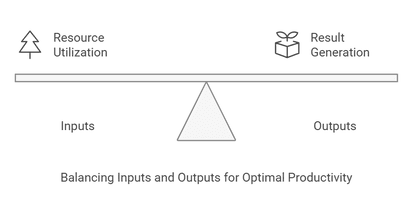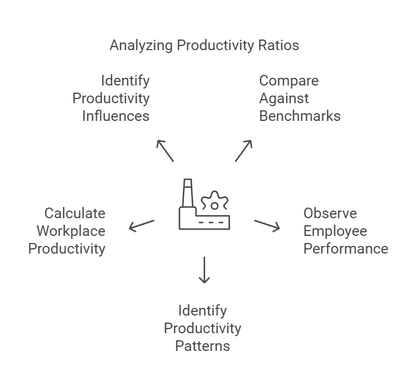How to Calculate Productivity in Business: Tools, Formulas & Strategies

Quick Summary
-
Use the simple formula (Output/Input) to check how well your team or business is doing.
-
Define inputs/outputs, apply formulas, and analyze results for better insights.
-
Use time-tracking and project management apps to simplify tracking and growth.
How do you track your business growth? Every business owner, manager, or entrepreneur must face this question at some point.
Growth is not only bound to increase revenue but also ensure that all of your resources and processes are engaged in the right way.
But how would you go about measuring that efficiency?
That's where the productivity formula comes in. On a basic level, it is the output vs. input ratio. It provides productivity KPIs (Key Performance Indicators) that work as the building blocks of growth analysis. Such KPIs can be operational efficiency, revenue per employee, employee performance, and even total sales.
In this article, we’ll discuss the following:
- Explore productivity formula with examples
- How to calculate productivity
- Important formulas for productivity
- Factors that affect employee productivity
- Tools for calculating productivity
It's time to move beyond guesswork and embrace measurable growth. Let's get started!
What is the Formula for Productivity?
Productivity is defined by the formula of outputs divided by inputs for a specified period. It measures the efficiency at which you or your team can turn inputs into outputs.
Whether it's project management, employee engagement, or workplace efficiency, productivity measurement suggests you take the right steps to enhance efficiency.
Here comes the productivity equation.
Productivity = Output / Input
Breaking Down the Input-Output Analysis of the Productivity Ratio

Input
Input refers to the resources used to achieve the output. Common inputs include:
- Time: Hours, days, or weeks spent.
- Labor: Number of employees or team members.
- Money: Costs incurred during production or operation.
- Materials: Raw resources used to create a product.
Output
Output refers to the deliverable or results achieved. Depending on the context, it could be:
- Units produced in a factory.
- Revenue generated by a business.
- Tasks completed in a project.
Examples of calculating productivity
Revenue per employee
This is one of the major productivity metrics that all types of businesses want to measure. It shows how well your workforce generates financial returns.
The equation of revenue per employee is
Productivity = Total Revenue / Number of Employees
Example:
A company generates $500,000 in revenue annually and has 50 employees. Using the formula:
Productivity = $500,000 / 50 employees = $10,000 per employee
Step-by-Step Guide on How to Calculate Productivity
Calculating productivity is pretty simple, whether it’s about employee productivity, metrics for team success, business efficiency strategies, or resource optimization metrics.
Here’s a step-by-step guide to help you through the process:
Step 1: Identify the Type of Productivity to Measure
First, understand what you're trying to measure. Productivity may vary by context. You have to focus on the right types of efficiency formulas. Common types include:
- Labor Productivity: How efficiently employees generate output (e.g., revenue or units produced).
- Operational Productivity: efficiently converting all available resources (inputs) into total output (goods or services).
- Personal Productivity: It measures productivity of how effectively individuals complete tasks in a set timeframe. You can find it by the total amount of hours worked versus the working hours per day.
Step 2: Define Input and Output
Clearly define the variables for your measurement. These will depend on the type of productivity you're calculating:
- Input: Resources used to achieve the result (e.g., time, labor, money, materials).
- Output: The result or deliverable (e.g., products produced, revenue earned, tasks completed).
Step 3: Apply the Appropriate Formula
Once you have identified inputs and outputs, apply the basic productivity formula. Modify the formula for specific scenarios as needed.
Step 4: Analyze and Interpret the Results

After calculating the productivity ratio, it’s time to analyze and interpret the results. These productivity ratios help you with workflow improvement. Applying all the business productivity calculations in the right way helps you:
- Compare against benchmarks
- Observe employee performance metrics
- Look for patterns over time
- Calculate workplace productivity
- Identify what affects productivity
Try Apploye for hassle-free productivity calculation
Important Formulas for Productivity
Several different productivity measures are available depending on your needs.
However, here are the most commonly used productivity formulas for small businesses, industries, and settings.
Basic Productivity Formula
The basic formula provides the productivity percentage. You can evaluate efficiency in the numeric value. This method is widely applicable across industries because it’s simple and adaptable.
Labor Productivity Formula
Labor productivity is a simple but powerful way to measure employee efficiency. It is one of the most used Productivity KPIs (Key Performance Indicators). With this metric, you can observe how well your employees are performing.
Labor productivity measures quantity and not quality. However, the overall productivity would be accurate if the quality improved.
Revenue Per Employee
Revenue Per Employee (RPE) denotes your company's revenue as per manpower.
This metric will give insights into your business's scalability, benchmark performance against competitors, and identify areas for improvement.
The metric assumes that every employee is equally contributing to revenue.
In contrast, some can play supporting or operational roles that do not directly bring in revenue, such as HR or finance. This might distort the accurate picture of individual employee contributions.
Manufacturing Productivity Formula
Manufacturing productivity can be defined as how the available production inputs, such as labor, materials, and equipment, are transformed into output in the manufacturing process. The formula enables firms to determine the efficiency of their production operations.
Manufacturers can make informed decisions that enhance efficiency, lower costs, and increase profits by applying formula variants.
Personal Productivity Formula
Personal productivity is the relation between the level of results produced by an individual within a specific time. It can be quantified using different measures depending on what one is tracking, such as tasks completed, time used, or goals realized.
The personal productivity formula is designed to quantify the relationship between input (effort, time, resources) and output (results, accomplishments, or goals).
Employee Feedback Productivity Formula
The employee feedback productivity formula is one way to gauge the level of feedback and its impacts on employee performance and productivity. When employees receive constructive feedback, it can change their working style, performance, and overall contribution to the organization's success.
It is a good metric for organizations to understand how well feedback works in enhancing the performance of employees. A well-structured feedback process leads to better employee engagement, skill development, and improved results across the organization.
Want to know more about the productivity formulas? Here are the details of productivity metrics for your business.
Factors Affecting Employee Productivity
Various factors can affect individual, team, and organizational productivity. Addressing these factors that impede efficiency is essential.
Here are some key factors that affect productivity:

Time Management
Time management is one of the most significant contributors to productivity. When people or teams cannot manage their time well, it takes longer to finish tasks, deadlines are missed, and the pace of work generally slows down.
Mismanagement of Resources
Proper allocation and utilization of resources are vital in achieving high productivity. Both human resources, such as employees or teams, and material resources, such as tools and equipment, and proper budgeting are needed. If you can’t synchronize them, you won’t get the expected result.
Employee Skills and Motivation
Skills and motivation directly influence employees' productivity at work. Even the best systems can only perform well with employee skills and motivation.
Well-trained employees with acquired skills will be more confident and effective at performing tasks.
Leadership and Management
It has to do with productivity and effective leadership. Bosses set expectations, guidance, and an environment wherein employees can thrive. Confusion, lack of direction, and low morale are involved with poor leadership, affecting their productivity directly.
Want data-driven productivity improvement? Read the 10 productivity improvement strategies your company needs to try.
Tools for Calculating Productivity
Tracking productivity requires the right tools and resources to measure progress, identify areas for improvement, and optimize workflows.
Whether tracking individual and team productivity or company performance, using the appropriate tools will simplify the process. Also, they provide insights and ensure you're on track toward your goals.
Here is the list of the productivity tools you may want to check out:
- Time-Tracking & Employee Productivity Tracking: Apploye
- Project Management Software: Apploye, Asana, and Jira
- Online Productivity Calculators: Calculator.net and Time Doctor
- Performance Dashboards: Tableau and Power BI
- Spreadsheets & Templates: Google Sheets and Microsoft Excel
- Kanban Boards: Trello
Conclusion
Productivity isn't about working harder; it's about working smarter. Give yourself the right strategies and resources. You will see more output with less waste of time and energy. The outcome is continued growth and success.
Whether you use the basic formula for simple tasks or more comprehensive methods, each method offers a different view of productivity. Tools like time-tracking apps, project management software, and online calculators make measuring, tracking, and optimizing productivity at every level easier.

